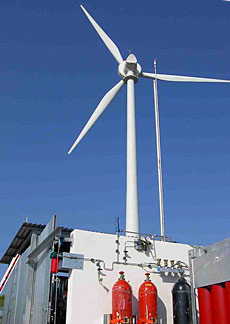RES2H2Hydrogen as a storage medium for optimal integration of renewable energiesThe wind's and sun's intermittent nature and the resulting lack of predictability in the generation of power can cause problems with respect to its feeding into the grid (see also the project HyWindBalance). Especially small grids, for example on islands, or poorly developed grid areas will have to cope with this problem. PLANET's rolePLANET was partner in the Greek sub-project and participated in the planning of this system. Our main goal was to avoid short start-stop-cycles of single components by choosing a sensible operating strategy under constantly changing conditions on the energy supply side. In addition, we tried to keep the energy consumption of the auxiliary machines as low as possible. During the operating phase, the computer model was optimised based on measured data. It has used in subsequent projects. We also contributed significantly to a market study on hydrogen made from renewables. The traditional channels of distribution for industrial gases are only of limited use. The main concern of our research was the production of hydrogen from surplus wind energy that will occur with increasing shares of wind in the power generation portfolio. It can become lucrative for the wind farmers to reconvert the hydrogen back to electricity, or to supply the hydrogen to different markets, namely sell it as a vehicle fuel (see also the projects HyFLEET:CUTE and CUTE). |
K. Stolzenburg, R. Steinberger-Wilckens, E. Varkaraki, N. Lymberopoulos, E.I. Zoulias, E. Kalyvas, C. Christodoulou, G.N. Karagiorgis:
Key Information The project ran from January 2002 to October 2007. The official project title was "Cluster Pilot Project for the Integration of Renewables into European Energy Sectors using Hydrogen". It had an overall budget of about 5 million €. 50% of this were covered by the European Commission under its 5. Framework Programme (contract no. ENK5-CT-2001-00536). |
|
|

|

